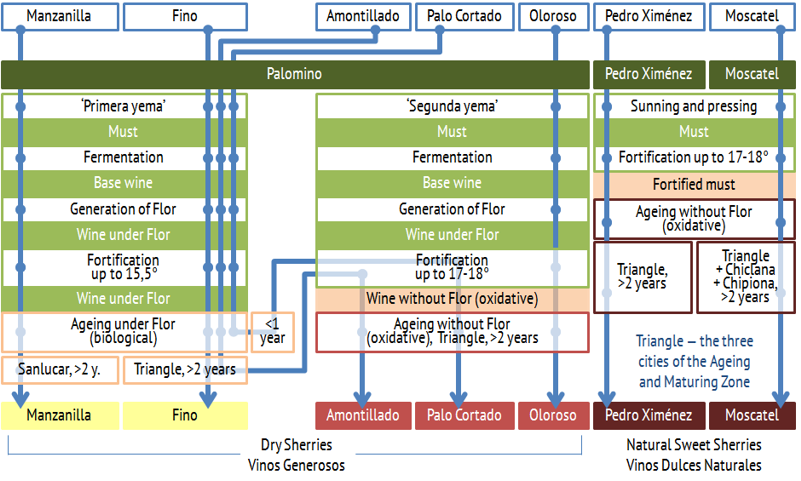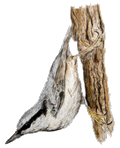
- Sherry Wine:
- Production
- Classification
- Cities & Bodegas
- Tastings
- Analogues
- Authors & Contacts
- Ðóññêèé ñàéò
Sherry wine
Sherry Wine Types
Olga Nikandrova and Denis Shumakov.
All sherries are divided into three groups: dry (Vinos Generosos), natural sweet (Vinos Dulces Naturales) and blended (Vinos Generosos de Licor).
Dry sherries are the ones that are produced from the wine which has undergone alcoholic fermentation (dry wine, in fact) and spend some time under flor. Dry sherries are Fino, Manzanilla, Amontillado, Palo Cortado (ageing under flor is a part of their production technology) and Oloroso (it is aged without flor, but flor develops on its surface before fortification with alcohol).
Natural sweet sherries are the ones produced from raisined grapes (the must comes out extremely sweet, flor doesn’t develop there — other yeasts can hardly survive there either). Natural sweet sherries are Pedro Ximénez and Moscatel.
Blended sherries are the ones that are made by means of mixing dry sherries with natural sweet ones, or/and with other ingredients. Blended sherries are Dry, Pale Cream, Medium and Cream.
The division of sherries into dry, natural sweet and blended ones complies with the EU standard for liqueur wines, to which sherry are attributed regardless of their sugar content — just because they are fortified wines.
Among other characteristics the Regulatory Council determines the type of the raw materials used, the place and the type of ageing for different sherries, the content of sugar and alcohol in them. Having omitted some nuances and tabulated the data demonstrating the differences between sherry types we have got the following (alcohol content is shown in degrees, sugar — in grams per liter, Triangle stands for Cities of Ageing and Maturing Zone).
The introductory material on types of sherry must contain a diagram with their production scheme (traditions must be followed). We did not include blended sherries there, as for dry and natural sherries — the diagram looks the following way.

Below are all known to us sherry types — official and not.
Dry sherries:
- Fino is a dry biologically-aged sherry;
- Manzanilla is a dry sherry aged biologically in Sanlúcar de Barrameda;
- Oloroso is a dry oxidatively-aged sherry;
- Amontillado is a dry sherry which has undergone long biological ageing and then full-length oxidative ageing;
- Palo Cortado is a dry sherry, which has undergone a short-term biological ageing followed by a full-scale oxidative ageing.
Natural sweet sherries:
- Pedro Ximénez is a natural sweet sherry produced from raisined grapes of Pedro Ximénez variety and oxidatively aged;
- Moscatel is a natural sweet sherry produced from very ripe or raisined grapes of Moscatel variety and oxidatively aged in the towns of the Zone of Ageing and Maturing, Chipiona and Chiclana de la Frontera.
Blended Sherries:
- Dry is a slightly sweet wine, pale yellow or golden in color, 15-22° alcohol, and 5-45-g/l sugar content. In fact, Dry is a slightly sweetened (with concentrated must, for example) Fino. In some markets Dry is released under such names as Pale or Pale Dry;
- Pale Cream is a sherry made by way of sweetening Fino (or — much more seldom — Manzanila) with natural sweet wines (Pedro Ximénez and Moscatel);
- Medium is a blend of Amontillado or Oloroso (Amontillado being a more wide-spread option) and natural sweet sherry. Commercial names for Mediums may use such words as Avocado, Golden, Amoroso (when it is based on Oloroso), Brown, Milk, Rich. The name Medium Dry may be applied for Medium sherries with a sugar content less than 45 g/l. Medium Sweet — for Medium sherries which have more than 45 g/l sugar.
- Cream is a most often is a mixture of Oloroso and natural sweet sherry. Sometimes the term Amoroso is used referring to Cream.
Old biologically aged sherries certified by the Regulatory Council:
- Manzanilla Pasada — old Manzanilla where flor has almost completely died of natural causes, due to the lack of nutrients and whose consumer qualities are certified by the Regulatory Council.
Old sherries with the certified average age:
- Oloroso 12, Oloroso 15, Oloroso V.O.S. è Oloroso V.O.R.S. — Oloroso whose average age is 12, 15, more than 20 and more than 30 years correspondingly;
- Amontillado 12, Amontillado 15, Amontillado V.O.S. è Amontillado V.O.R.S. — Amontillado whose average age is 12, 15, more than 20 and more than 30 years correspondingly;
- Palo Cortado 12, Palo Cortado 15, Palo Cortado V.O.S. è Palo Cortado V.O.R.S. — Palo Cortado whose average age is 12, 15, more than 20 and more than 30 years correspondingly;
- Pedro Ximénez 12, Pedro Ximénez 15, Pedro Ximénez V.O.S. è Pedro Ximénez V.O.R.S. — Pedro Ximénez whose average age is 12, 15, more than 20 and more than 30 years correspondingly.
At least some characteristics of the aforementioned sherries are regulated by the Regulatory Council’s documents. The characteristics of the sherries listed below are not legally set forth — they are defined by producers.
Vintage sherries:
- Oloroso Añada — vintage Oloroso;
- Palo Cortado Añada — vintage Palo Cortado.
Non-filtered (slightly filtered) sherries:
- Fino en Rama — Fino which does not fully undergo the traditional filtering and clarification procedures after the wine is taken from the solera and before bottling;
- Manzanilla en Rama — Manzanilla, which does not fully undergo the traditional filtering and clarification procedures after the wine is taken from the solera and before bottling.
Sherries with outdated or unregulated names:
- Fino Amontillado — old Fino where flor has almost completely died of natural causes, due to the lack of nutrients so the sherry started a gradual transition from biological to oxidative ageing;
- Amontillado Fino — old Fino where flor has completely died of natural causes, due to the lack of nutrients so the sherry started a gradual transition from biological to oxidative ageing;
- Puerto Fino — Fino produced in El Puerto de Santa Maria;
- Manzanilla Amontillado — old Manzanilla where flor has completely died of natural causes, due to the lack of nutrients;
- Amontillado del Puerto — Amontillado produced in El Puerto de Santa Maria;
- Jerez Cortado — Palo Cortado produced in Sanlúcar de Barrameda.
Here. Studying this list, one should keep one obvious idea in one’s head. Sherry culture is a living and constantly evolving culture. From time to time sherry producers come up with sherry novelties that go beyond any existing classification. Sometimes such new products may remain unnoticed, sometimes they create a new trend. So, immersing yourself in the sherry culture, be prepared for surprises (here, for example Manzanilla Añada) — and enjoy them.
Now, to the details. A little boring and repetitive, but so it should be. We’ll also say a few words about Brandy de Jerez. But a bit later. We’ll start with Fino.
Warning!
This site can contain information about drinks excessive consumption of which may cause harm to health and is unadvisable for people who didn’t come of age.
Share Sherry
- Sherry.wine, FEDEJEREZ
- Copa Jerez, Sherry Week
- Sherry Notes, Jerez de Cine
- Los Generosos, Criadera
- Jerez-Xeres-Sherry
- Los Vinos de Jerez
Articles
- There are more articles in Russian than in English in this website. Sorry :(
Reviews
- To our great regret, we didn’t have time to translate tasting and traveling notes into English. But, if you want, you can see them in Russian.

